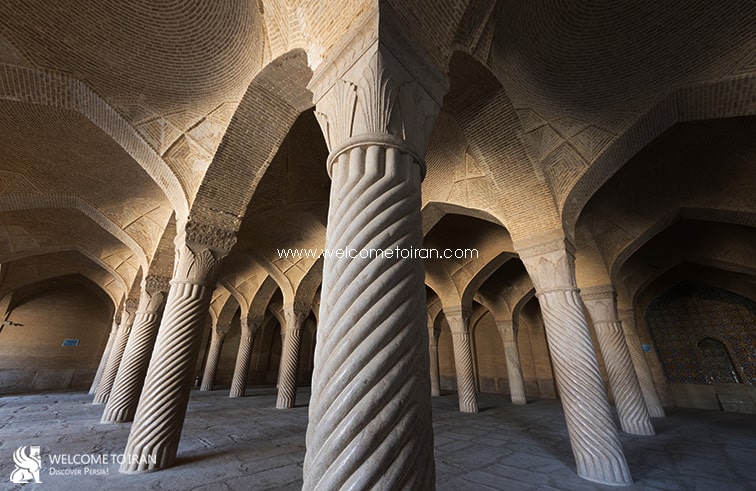After the arrival of Islam in Iran, there were many mosques throughout Iran and in different historical periods. One of these historical mosques which its architecture and glory is well-known for domestic and incoming tourists, is Vakil mosque built by Karim Khan Zand (1187 AH). The mosque is located next to Vakil Bazaar and the Vakil Bath, creating a massive complex.
History of Vakil Mosque
At the time of Karim Khan-e Zand (Vakil oroaya) (1187 AH), Shiraz was the capital of Zandieh government and it was Karim Khan’s attention. In this period, many monuments were built that Vakil Mosque except them.
Two narrations have been quoted from Karim Khan about construction of this mosque, which we define it further:
During the construction, architects emphasized the mimbar, altar, inscriptions and tiles because they represented the glory of the mosque, but Karim Khan who was one of the most popular kings in Iran history, emphasize on the people’s needs. So he encouraged the workers to build W.C the best possible .He said that “If God would like to bless me, it is because of this service and not the mosque because the people need it more.”

It is also quoted that Karim Khan emphasized to build the mosque as soon as possible, so he invited from musicians to play music in order to creation a happy atmosphere and the workers do their job better.
Pierre Loti has wrote in his travelogue “Today, fortunately, I succeeded to visit Karim Khan Mosque, if I stay here for a while; I will enter all the places that are completely prohibited for me now. The people of this city are very gentle and kind to me. The architecture design and pattern of the mosque is simple but there are Mina Kari (Enamel), green and red colors everywhere, and this glorious art exceed its limit. Cannot be found anywhere without Enamel. We are in a turquoise and Lajevardi (Persian blue) palace, now.”
Architecture of Vakil Mosque
The mosque’s plan is two-porch and has two Shabestan (a large columned hall in the mosque) in the direction of south and north. The different parts of the mosque include entrance, hallway, atrium, mimbar, Shabestan and porch have beautiful design, but the three arches of the mosque have another magnificent view and are seen more in the photos.
One of the features of Iranian architecture is Mardomvari (Humanism) in the opinion of Dr. Karim Pirnia, in the sense that the each part of the monument is proportionate to people and their needs. This feature is also observed in Vakil mosque. The size of Shabestan and the lack of minarets and ornament in order to create a spacious space for prayers are examples of this characteristic.
 Entrance
Entrance
To visit the mosque, you will pass through an entrance that its ornamentation; tile and calligraphy are beautiful examples of Islamic architecture. There is also an inscription with some Qur’an’s verses. Two companions with a height of 8 and a width of 3 meters have given it a special glory. After passing through the short hallway, you will be directed to the atrium.
Courtyard
The mosque has two courtyards that the atrium has a dimension 65 x 60 and a smaller yard is 35 x 20. There are rectangular pools in both courtyards. The smaller yard is located in the northeast; you will arrive through pass a small hallway.
Arch and porch
In the northern porch, a high arch has a beautiful effect with two tiles finials. Other arch is named pearl; it is decorated with Haft-rang (Seven color) tiles and geometric and herbal pattern. There are inscriptions with Quran verses contents. In front of the pearl arch (Morvarid arch), there is another arch decorated with engraved stones and Haft-rang (Seven color) and Moraq tiles. On the west side there are 11 arches decorated with tiles and Quran verses. Symmetrically, there are the same arches on the eastern side. Behind these arches, a colonnade shows tile and beautiful paintings.

Shabestan, altar and mimbar
On the southern and eastern sides of the mosque, there are two shabestan that the southern Shabestan is considered as one of the beautiful ornaments of Iran mosques. What makes this part of the mosque attractive is the integrated pillars that have a mysterious simplicity. Forty-eight spiral columns in four rows and a height of 5 meters in addition to keeping the roof, has provided eye-catching beauty.

The mimbar of the mosque is made up of marble, and because of 14 imams in the Shia religion, its steps are 14. It is quoted that the stone has been brought from Maragheh and it was very expensive with the facilities of that time.
The altar is located on the right side of the mimbar which ornamented by calligraphy, Moqarnas, which done professional by architects.




